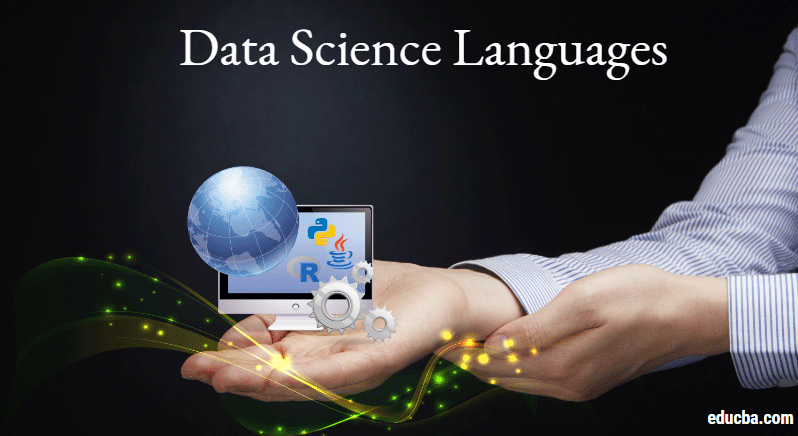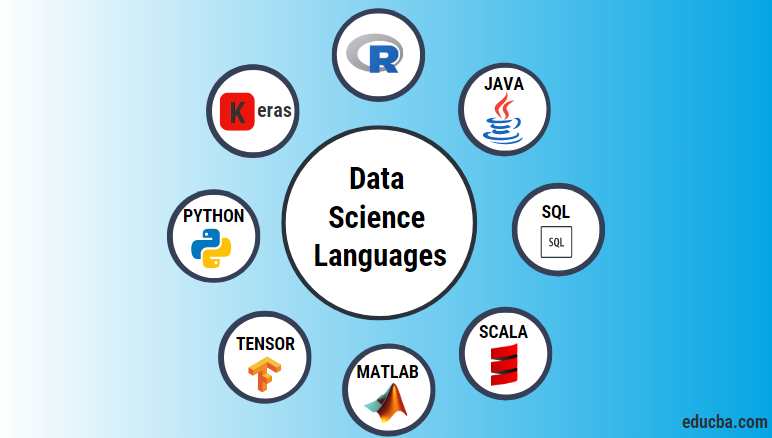Updated March 15, 2023
Introduction to Data Science Languages
Data science has been among the top technologies today and has become marketwide a strong buzzword. A data scientist is one of the key roles which has to make do with mathematical problems and analytical solutions and is also expected to work, understand, and know equally well programming languages useful for data science and machine learning. There becomes a need to access the data you gather, and for that, the perfect blend of the right skill and a perfect tool is needed so that you are provided with the results as per your expectations with the information provided.
Data science’s scope is increasing day by day and is expected to increase in many more future years to come. Data science considers many domains, such as statistics, mathematics, information technology, computer science, etc. You should really have a good hands-on upon one of the languages but having more than one language in your resume is never a bad idea. Due to the growing demand of data scientists and data science enthusiasts, it becomes urgent to make a combined list of all the possible data science languages.
Top Programming Languages in Data Science
Data Science has many technical languages used for machine learning.
1. Python
First and foremost, the language you must have heard about in your surroundings is the Python programming language. It is effortless to read and code; functional programming language participates in the core development area and effectively helps in data science. Most libraries have been predefined in this very language. The libraries include sci-kit learn, pandas, numpy, sci-py, matplotlib, etc.
One of the main reasons Python has been gaining so much popularity is its ease and simplicity among the programmers and its agility and ability to quickly combine and integrate with the top-performing algorithms, typically written in Fortran or C language. Furthermore, with the advent and sharp advancement of data science, predictive modeling, and machine learning, Python developers’ increasing demand is rising exponentially. Therefore, it is being used significantly in web development, data mining, scientific computing etc.
2. R programming
One statistical language, if it doesn’t have to be about Python, has to be definitely about R. This is quite a legacy language when compared to Python and its natives, becoming one of the most widely used instruments as an open-source language, and the R Foundation offers a graphics and statistical computing software environment for statistical computing. This domain’s skillsets have very high chances of jobs as they are closely associated with data science and machine learning. This language is solely built for analytical purposes, and therefore it provides many statistical models. The public R package repository and the archival list consist of 8000+ network contributed packages. RStudio, Microsoft, and many top giants have contributed and are supported by the R community.
3. Java
When it has to be about Java, I don’t think much of an explanation is actually required. This has been an evergreen programming language present and doing way too successfully in every technology domain it has entered. Former Sun’s protégé and now Oracle’s, the latter has been keeping in view the new features relevant to the day-to-day market in every new Java release. It is mainly used to be the backbone of any architecture and framework. Therefore, data science is used to communicate and establish a connection and manage the working of the underlying components responsible for making machine learning and data science happen.
4. Scala
One other popular programming language that has come into play is the scala functional programming language, which was based mainly on a deal with Apache spark and its working, enabling it to work faster and optimize performance. This one is again an open-source and a general-purpose programming language which directly runs on top of JVM. This is mainly associated with Big data and Hadoop and therefore works well when the use case is about large volumes of data. It is a strongly typed language and therefore becomes easy to deal with a language among the programmers. Moreover, its support with the JVM or the Java Virtual Machine allows interoperability with Java language. Therefore, the scale can be a powerful general-purpose programming language, thereby becoming one of the top choices in this field.
5. SQL
Structured Query Language or SQL (as popularly abbreviated) is the core of databases and backend systems and is among the most popular languages in data science. It is used well in querying and editing information which is typically stored in relational databases. It is also mainly used for keeping and fetching data for decades.
This becomes among the popular choices when it has to reduce the query times, turnaround times and manage large databases using its fast processing time. One of the biggest assets which you can have in the field of data science and technology, in general, is to learn the use of SQL language. Today, there have been many other querying components and many other NoSQL databases present in the market, but they all have their roots in the SQL programming language.
6. Matlab
This one is among the core data science languages responsible for quick, solid and stable algorithms to be used for numerical computing. It is considered to be among the best-suited language for scientists, mathematicians, statisticians, and developers. It can easily play along with typical mathematical transformations and concepts such as Laplace, Fourier, Integral and differential calculus.
The best part about data science enthusiasts and data scientists is that this language provides a wide array of inbuilt and custom-built libraries, which are useful for emerging data scientists as they do not have to dig in deep to apply the knowledge of Matlab.
7. TensorFlow
One of the widely used languages which marks a presence in the field of data science is Tensorflow. Google develops this, and this open-source library is gaining to be much more popular when it comes to doing numerical calculations and computations. This framework works on the large suitability of the data. It is used in cases such as graphical computations where it can make use of tuned C++ code.
One of the major advantages of using TensorFlow is that it uses GPUs and CPUs along with distributed programming. This works on the concept of deep learning and can train huge neural networks on the set of immense data in a short span of time. This is termed as the second level of generation system from the Google Brain team, which powers a large scale of services such as Google Search, Cloud Speech and photos.
8. Keras
Keras is a minimalist library of Python that is used for deep learning. It runs on top of Theano or TensorFlow; its main aim was to implement machine learning models easily and quickly for developmental and research purposes. This can be seen to be running on the legacy version of Python and the current version, i.e. 2.7 or 3.5. and it can be seen to be seamless when running on CPUs or GPUs. It makes use of the four guiding principles viz—minimalism, modularity, Python, and Extendability. The focus is the model idea, and the major model is the sequence which is a layer of linear stacks.
This means that the layers are to be added in the created sequence, and the computation has to be done in the order of the expected computation. Once whenever you define, you can use the compiled model, which uses the underlying frameworks and the components to optimize the computation, thereby specifying the loss function and being used optimizer; the model is then checked for viability and fit with data. This can be done with one batch of data at a particular time or by firing off the entire model training regime. The models can then be used for predictions. The construction can be summarized as follows, defining the model, make sure it’s compilable, fitting your model, making predictions upon it.
Conclusion
Various data science programming languages are being used widely in the markets today. It cannot be outrightly said if one language is better than the other in any way. It totally depends on the kind of use case you have in your project or organization, and the language can be chosen accordingly; all the languages have their own pros and cons, and therefore, a basic level of introductory analysis is required to know which is the right language to be used in data science for you. I hope you liked our article. Stay tuned for more like these.
Recommended Articles
This is a guide to Data Science Languages. Here we have discussed the basic concept with 8 different types of languages used in data science. You can also go through our other suggested articles to learn more –




